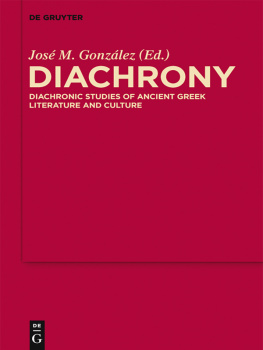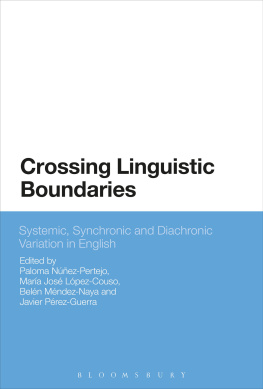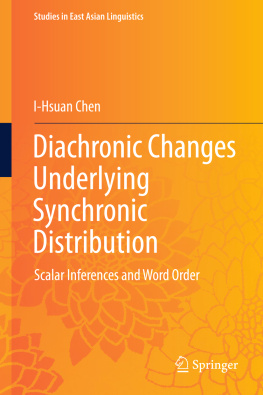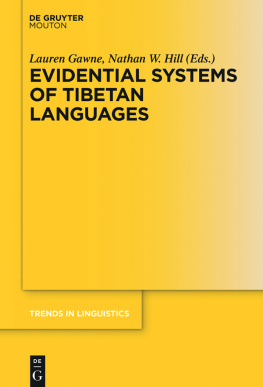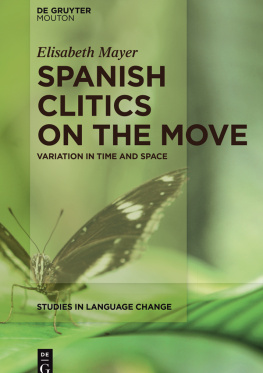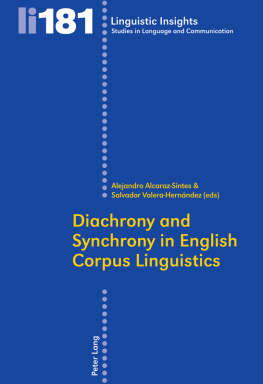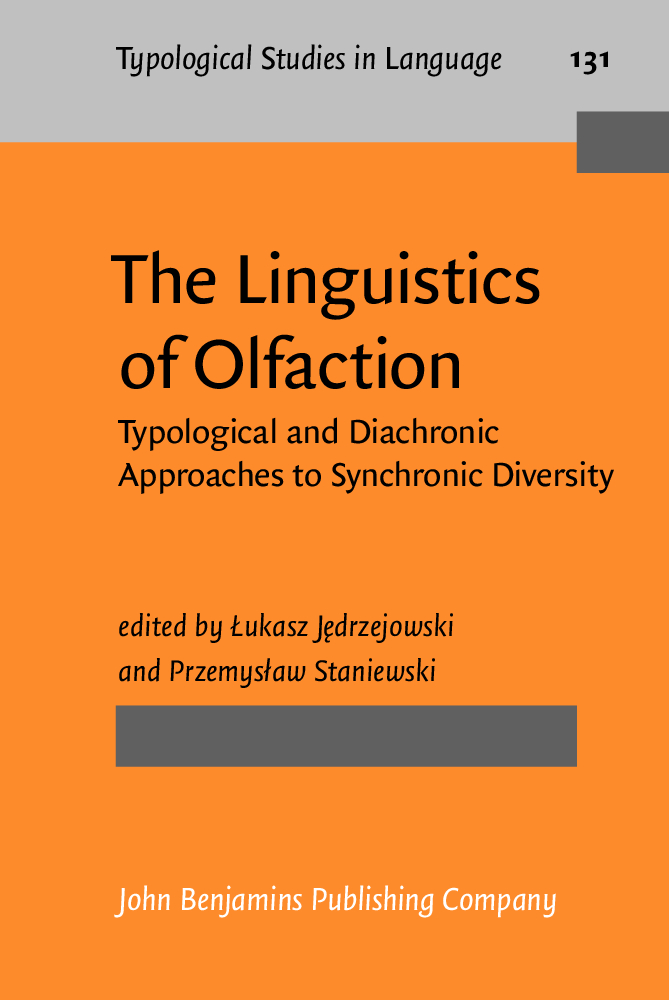

The Linguistics of Olfaction
Typological and Diachronic Approaches to Synchronic Diversity
ukasz Jdrzejowski & Przemysaw Staniewski University of Cologne | University of Wrocaw
doi: 10.1075/tsl.131
ISBN: 978 90 272 6017 8 (ebook)
Cataloging-in-Publication Data available from Library of Congress:
LCCN 2020056534
2021 John Benjamins Publishing Company
2021 John Benjamins Publishing Company
John Benjamins Publishing Company https://benjamins.com
John Benjamins Publishing Company
Preface and acknowledgments
The collection of chapters included in this volume goes back to a selection of contributions to the workshop entitled Towards a Typology of Olfactory Expressions convened and organized by the volume editors, ukasz Jdrzejowski and Przemysaw Staniewski, at the 49th Annual Meeting of the Societas Linguistica Europaea at Naples, 31 August 3 September, 2016.
We thank the organizers of the SLE conference and administration of both conference and workshop, in particular Michela Cennamo, Bert Cornillie, and Ana Daz-Negrillo.
Additionally, we would like to thank all internal and external reviewers who were willing to review chapters collected in this volume. In particular, we are indebted to (in alphabetical order): Odelia Ahdout, Anna Bondaruk, Denis Creissels, Katarzyna Dziwirek, Chiara Fedriani, Beatriz Fernndez, Joana Garmendia Mujika, Donna B. Gerdts, Bjrn Hansen, Birgit Hellwig, George Hewitt, Gianina Iordchioaia, Itamar Kastner, Paul Jen-kuei Li, Carsten Levisen, Zohar Livnat, Piera Molinelli, Heiko Narrog, Alexandru Nicolae, Teresa Oliveira, Carolyn OMeara, Seongha Rhee, Violeta Vzquez Rojas Maldonado, Marcin Trojszczak, Dorinda Tsai-hsiu Liu, Kevin Tuite, Kilu von Prince, Bodo Winter, and Karolina Zuchewicz. Our thanks go also to the editorial board of the series Typological Studies in Language and to Kees Vaes for their constructive and meticulous suggestions.
Finally, we are grateful to all the authors for taking time and putting effort into contribution to this collection. Without their patience and forbearance with our many questions, the completion of this work would not have been possible.
Kln / Wrocaw, February 2021
ukasz Jdrzejowski & Przemysaw Staniewski
Rendering what the nose perceives An introduction
ukasz Jdrzejowski & Przemysaw Staniewski University of Cologne | University of Wrocaw
In this chapter, we briefly overview the typological and diachronic research on olfactory expressions and point out possible further research questions. Essentially, we illustrate how linguistic olfactory terms interact with different areas of grammar, e.g. with morphology, and delineate some striking cross-linguistic patterns calling for a deeper unification of language-internal and language-external factors.
Keywords
- sense of smell;
- olfactory perception;
- sense modalities;
- typology;
- diachrony
Introduction
Olfactory perception is increasingly attracting attention in different research fields. In neuroscience, for instance, smell training is deemed to improve olfactory function and to alter brain structure, as recently shown in An et al. (2019). Relatedly, olfactory dysfunctions help identify pre-clinical signs of diseases, compare study of zebra finches, Taeniopygia guttata, shows that fledglings are capable of recognizing their own nest based on olfactory cues alone.
Novel research findings on smell can also be observed in linguistics. As Viberg (this volume) points out, the way people conceptualize and talk about smell varies across cultures. Typologically, the variation of lexical olfactory expressions ranges from a few (e.g. in Indo-European languages) to over a dozen inherent olfactory lexemes (cf. e.g. on ineffability). It is therefore tempting to linguistically examine the variation in olfactory expressions and ask where it comes from.
The main aim of this brief introduction chapter is to give a general overview of what is known about selected linguistic aspects of olfactory expressions cross-linguistically, to elaborate on selected topics as well as on open issues, and, finally, to point towards possible future research directions. This overview is by no means exhaustive. Rather, it is supposed to make the reader familiar with the extent to which olfactory expressions have been examined in the literature and to comment on striking cross-linguistic peculiarities. As it will turn out, addressing both issues will considerably help identify the far-reaching theoretical consequences that may follow from the typological picture.
On the variation of olfactory terms
There are several independent reasons for examining olfactory expressions. :236), for example, points out that the sense of smell is much more diverse than other senses, both in respect to how smell is encoded linguistically in a particular language and in respect to the number of sensations it can distinguish. In what follows, we elaborate on some of such reasons.
2.1 Lexical repertoires
One of the central typological tasks is to identify and examine linguistic expressions denoting a smell in a particular language. Regarding this, cultural contexts and social environments often determine the vocabulary as well as the development of morpho-phonological and syntactic patterns leading to linguistic variation and diversity across languages. A heterogeneous realization of a single linguistic category can also be observed with regard to the linguistic encoding of olfaction. The received wisdom has it that the terminology of olfactory expressions is generally poorly developed in Indo-European languages, see for example gives a general overview over main olfactory verbs in selected Germanic languages:
Table 1.
Main olfactory verbs in Germanic languages
| positive | neutral | negative |
|---|
| Afrikaans | ruik | stink |
| Danish | dufte | lugte | stinke |
| English | smell | stink |
| German | duften | riechen | stinken |
| Icelandic | ilma | lykta |
| Luxembourgish | richen | stnken |
| Norwegian | dufte | lukte | stinke |
| Swedish | dofta | lukta | stinka |
What the Germanic languages have in common is that they possess two/three main olfactory verbs denoting additionally a hedonic value and a small number of other word classes derived from these verbs. This mainly accounts for why these languages are taken to have a poorly developed olfactory system. Yet, recent studies have shown that in some cultures (cf. e.g. Jahai or Maniq) the olfactory vocabulary can be very abstract and rich, cf. summarizes their findings and shows that Seri speakers have around ten different verbal predicates at their disposal denoting smells (comparable sets of olfactory terms have also been described for Jahai and Maniq):
Table 2.
Verb roots in the Seri olfactory lexicon and their exemplars according to
| Verbal predicate | Possible referents for subject of verb |
|---|
| -heemt |



